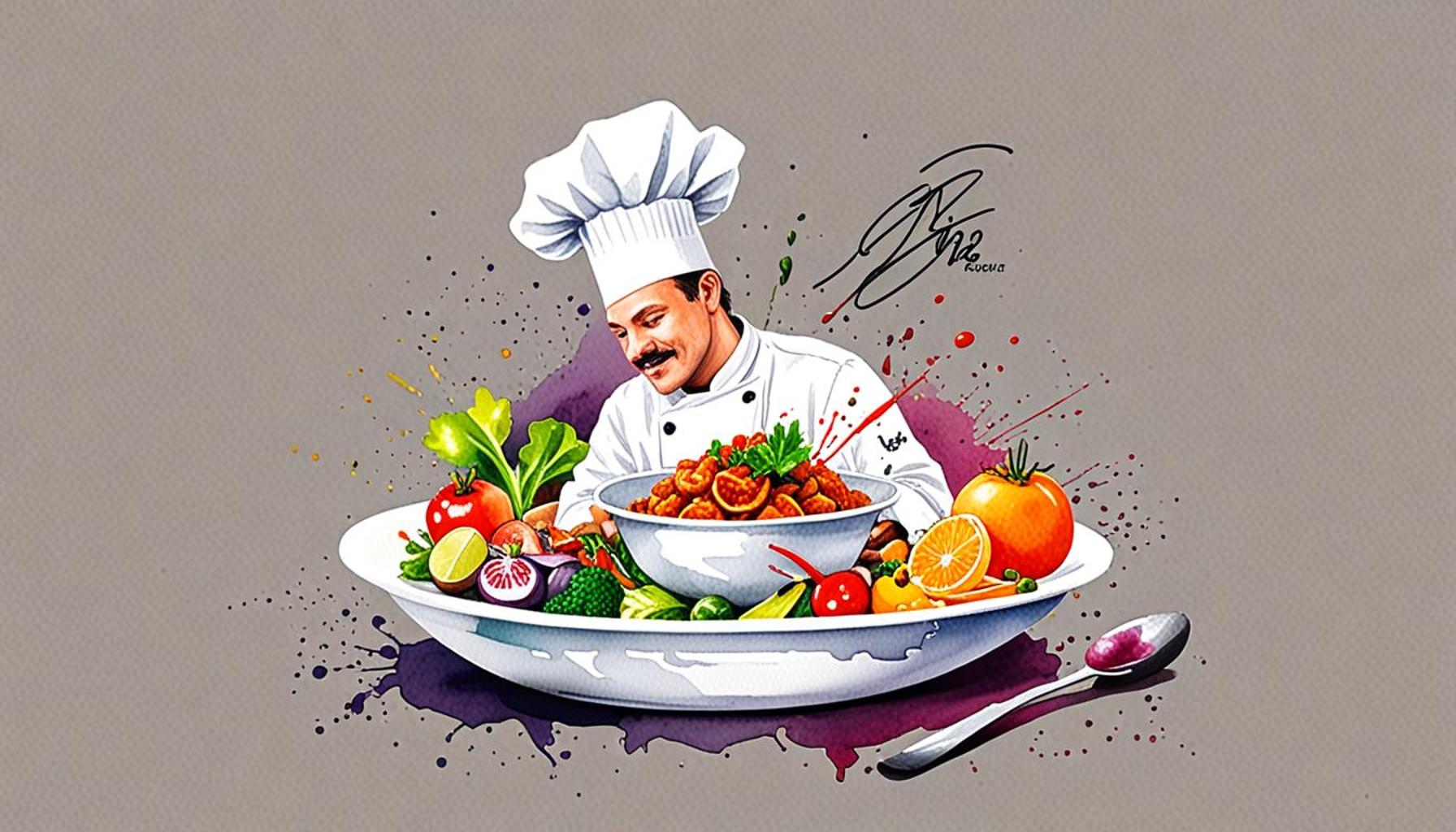Blending Flavors How International Cuisine Shapes Nigerian Chefs

Introduction
In a world where culinary boundaries are constantly evolving, Nigeria’s vibrant food scene stands as a testament to this transformation. Chefs across the nation are not just custodians of traditional recipes; they are pioneers, skillfully integrating global flavors into their kitchens. This dynamic blending of cuisines pushes the limits of creativity and innovation within the culinary art, shaping a distinct identity that appeals to both local and international palates.
The influence of international cuisine is particularly relevant as it promotes a spirit of experimentation among chefs, steering them away from conventional recipes. Exposure to diverse cooking techniques opens up a world of possibilities, enabling chefs to create dishes that are a fusion of tradition and modernity. As we explore this exciting culinary landscape, we’ll delve into the top five ways international cuisine inspires Nigerian chefs.
- Ingredient Substitution: Introducing global ingredients into local dishes.
- Innovative Techniques: Adapting cooking methods from different cultures.
- Flavor Combinations: Merging spices and flavors for unique tastes.
- Presentation Styles: Embracing international plating aesthetics.
- Cultural Storytelling: Using food to convey personal and cultural narratives.
Join us as we uncover the remarkable ways international influences are shaping the culinary creativity of Nigerian chefs.
ADDITIONAL INSIGHTS: Expand your understanding here
Melding Flavors: The Influence of International Cuisine on Nigerian Chefs’ Creativity
The culinary world is an extraordinary tapestry woven together by the diverse and ever-evolving flavors and techniques from around the globe. In Nigeria, a vibrant culinary scene is flourishing as chefs eagerly draw inspiration from international cuisines, skillfully blending these influences with local traditions to create innovative and exciting dishes. This article delves into the top five international culinary influences that are reshaping the creativity of Nigerian chefs, revealing how they are revamping traditional dishes while introducing new concepts to the Nigerian palate.

5. Fusion of Traditional Nigerian Ingredients with Asian Flavors
One of the most stimulating developments in Nigerian cuisine is the seamless integration of Asian flavors. Local chefs are exploring the rich tastes of Nigerian staples, such as yam and jollof rice, and enhancing them with the depth and complexity often found in Asian cooking styles. This cross-cultural culinary experiment includes ingredients like ginger, lemongrass, and coconut milk that have the power to transform a classic Nigerian stew into an unforgettable Asian-inspired delight.
A few innovative combinations capturing this Asian-Nigerian fusion include:
- Jollof fried rice with soy sauce: By substituting the traditional tomato base with soy sauce, chefs introduce an intriguing umami twist to this beloved Nigerian dish.
- Yam croquettes with Thai chili dip: The addition of sweet chili sauce as a dip lends a unique zest to this cherished root vegetable, creating a tantalizing clash of flavors.
This blend of culinary practices not only expands flavor profiles but also pushes Nigerian chefs to adopt new cooking techniques. The international trend towards health-conscious eating is further encouraging cooks to incorporate fresh herbs and vegetables from Asian cuisines, crafting a healthy fusion that respects the nutritional principles of both. This evolution marks a new era where traditional recipes are enlivened by global influences, enriching the dining experience.
4. Influences from Mediterranean Cuisine
The Mediterranean’s approach to food, renowned for its emphasis on fresh ingredients and light, healthful dishes, offers rich influences for Nigerian chefs. They are increasingly adopting Mediterranean techniques such as grilling and roasting, which enhance the natural flavors of local produce. The use of olive oil, garlic, and a variety of fresh vegetables is becoming a staple in Nigerian kitchens, echoing Mediterranean dietary habits.
Examples of this fruitful exchange include:
- Tomato and okra salad with feta cheese: This blend of traditional Nigerian ingredients with tangy Mediterranean cheese results in a refreshing salad that tantalizes the senses.
- Peppered fish with balsamic glaze: Marrying Nigerian spice blends with Italian-style balsamic notes, this dish provides a sensational cross-cultural culinary experience.
This exchange not only revitalizes traditional flavors but also promotes a balance between indulgence and health, broadening the appeal of Nigerian cuisine both locally and internationally. The inclusion of Mediterranean methods brings a refreshing perspective that appreciates the art of eating well while savoring every bite.
3. Latin American Culinary Techniques
The vibrant and diverse flavors of Latin American cuisine have made significant inroads into Nigerian gastronomy, with chefs eagerly adopting cooking techniques and ingredients from countries like Mexico and Brazil. The incorporation of smoked chilies, beans, and tropical fruits adds an intriguing layer to Nigerian dishes, offering familiar flavors a novel twist.
Nigerian chefs are creatively reimagining their culinary creations by injecting them with Latin American flair:
- Nigerian plantain tacos: These delightful snacks or appetizers feature spicy beans and grilled meats encased in plantain “taco shells,” offering a bold fusion of flavors.
- Chili pepper sauces: Enhancing traditional Nigerian pepper sauces with Latin spices intensifies the heat and elevates the flavor profile, appealing to adventurous diners.
This melding of flavors underlines the adaptability of Nigerian cuisine, offering diners rich taste experiences that celebrate culinary diversity. It exemplifies how food can transcend borders, uniting disparate cultures through the universal language of taste.
2. Embracing the American Fast-Casual Dining Concept
The influence of fast-casual dining trends from the United States is becoming increasingly visible in Nigerian urban centers. Chefs are reinventing classic dishes to create quick, exciting menu items that cater to the fast-paced lifestyle of city dwellers. The creative use of street food elements, gourmet burgers, and wraps reflects this growing interest in casual dining experiences.
Adaptations include:
- Gourmet suya burgers: Combining traditional Nigerian suya with a modern bun creates a contemporary favorite that resonates strongly with a younger audience.
- Wraps filled with spicy Nigerian grilled chicken: This innovative take on traditional meals offers a convenient option perfect for quick consumption amid busy schedules.
This trend signifies a shifting paradigm in Nigerian dining preferences, highlighting the growing acceptance of diverse food formats that make Nigerian cuisine more accessible and inviting to various demographics. It underscores culinary versatility while respecting traditional flavors in new and exciting ways.
1. The Global Influence of Gastronomic Innovation
The pinnacle of international influence on Nigerian cuisine lies in a wave of gastronomic innovation driven by an enthusiastic cadre of chefs. These culinary visionaries embrace techniques from around the world, implementing them in imaginative ways that propel both local and global flavors to new heights. Molecular gastronomy, for example, offers chefs the tools to deconstruct and reconstruct traditional dishes, presenting familiar tastes in extraordinary formats.
Examples of this modern approach include:
- Deconstructed egusi soup: By utilizing techniques like reduction and foam generation, chefs transform this age-old dish into a fine dining experience with complex textures.
- Spice-infused desserts: Incorporating spices typically reserved for savory dishes into sweets, such as chocolate infused with African red pepper, introduces diners to unexplored flavor territories.
This innovative spirit is redefining the boundaries of what constitutes “traditional” Nigerian cuisine, presenting it as a living, breathing art form open to reinterpretation and exploration. The infusion of global culinary techniques emboldens Nigerian chefs to break the mold while honoring their culinary heritage, capturing the imagination of food enthusiasts worldwide.
In conclusion, the influence of international cuisine on Nigerian chefs is both profound and multifaceted. By ingeniously weaving the flavors and techniques of Asia, the Mediterranean, Latin America, and America into their culinary repertoire, chefs are not only enriching the Nigerian dining scene but are also sharing a piece of the world through the universal act of eating. As they continue to experiment and innovate, the exciting blend of flavors promises to elevate Nigeria’s culinary status on the global stage, inviting food lovers everywhere to join this delicious journey.
| Culinary Techniques | Influences on Nigerian Cuisine |
|---|---|
| Fusion Cooking | Chefs blend traditional Nigerian ingredients with international cooking methods, resulting in unique flavors. |
| Presentation Styles | Modern plating techniques from global cuisine enhance the visual appeal of dishes. |
| Cultural Exchanges | Impact on Nigerian Chefs |
|---|---|
| Travel and Training | Exposure to global culinary schools broadens skills and ignites creativity. |
| Collaboration | Chefs collaborating with international cuisines create innovative dishes that reflect a mixture of cultures. |
| Ingredient Diversity | Benefits to Cuisine |
|---|---|
| International Spices | The inclusion of global spices elevates traditional flavors to new heights. |
| Seasonal Ingredients | Incorporating seasonal fruits and vegetables creates freshness and vibrancy in dishes. |
| Consumer Preferences | Shifts in Taste |
|---|---|
| Healthy Options | The demand for healthy international dishes drives innovation in Nigerian recipes. |
| Trend Awareness | Nigerian chefs stay updated with global culinary trends, influencing local dining experiences. |
The exploration of international culinary influence on Nigerian chefs reveals a landscape filled with opportunities for innovation and creativity. Chefs are now more than ever incorporating diverse techniques and ingredients, reflecting a global palette in their work while maintaining the essence of traditional Nigerian cuisine. Such adaptations not only enhance the dining experience but also contribute significantly to cultural exchange and appreciation. The continuous evolution of Nigerian culinary art is a testament to the power of fusion, collaboration, and the relentless quest for flavor and aesthetic brilliance.
ADDITIONAL INSIGHTS: Expand your understanding here
Frequently Asked Questions about “Mixing Flavours: The Influence of International Cuisine on the Creativity of Nigerian Chefs”
What are some examples of international cuisines influencing Nigerian chefs?
In recent years, Nigerian chefs have been creatively incorporating elements from a variety of international cuisines, such as French, Italian, and Japanese. For instance, the use of French cooking techniques like sous-vide, Italian ingredients such as truffle oil, and Japanese staples like miso and wasabi have been reimagined in Nigerian dishes, adding a unique flavor profile while respecting traditional culinary roots.
How have Nigerian chefs maintained cultural authenticity in the face of global influences?
Nigerian chefs strive to maintain cultural authenticity by using local ingredients and traditional cooking methods as the foundation of their dishes. Even when incorporating international flavors, they emphasize a balance that highlights indigenous spices and culinary customs, ensuring that the essence of Nigerian cuisine remains intact while introducing new taste dimensions.
Why is the blending of international cuisines important for the evolution of Nigerian culinary arts?
The blending of international cuisines encourages culinary innovation, allowing Nigerian chefs to experiment and push the boundaries of traditional cooking. This culinary fusion not only elevates the global profile of Nigerian cuisine but also fosters creativity and offers a fresh perspective that can enhance the nation’s gastronomic identity on the international stage.
What are the challenges Nigerian chefs face when incorporating international cuisines?
Nigerian chefs often encounter challenges such as sourcing authentic international ingredients locally, which can be limited or expensive. Additionally, it can be tough to balance traditional flavors with new international elements in a way that appeals to local palates without alienating diners accustomed to traditional dishes. Navigating these challenges requires both creativity and strategic planning.
How do diners in Nigeria respond to fusion cuisines introduced by local chefs?
Many Nigerian diners have embraced the creativity and diversity that fusion cuisines offer, appreciating how familiar flavors are transformed with international influences. However, there is still a segment of the population that prefers traditional dishes without alteration. Educating and engaging diners about the value of culinary fusion is crucial for broader acceptance and enjoyment.
ADDITIONAL INSIGHTS: Expand your understanding here
Conclusion: A Culinary Tapestry of Influence
As we delve into the vibrant and evolving world of Nigerian cuisine, it becomes evident that international culinary influences have played a crucial role in enhancing and invigorating the creativity of Nigerian chefs. Through the art of blending diverse flavors, these chefs are not only preserving their rich culinary heritage but also paving the path for innovative gastronomic creations that captivate food enthusiasts worldwide.
From the incorporation of Asian spices to the adoption of European cooking techniques, the fusion of international elements has led to a great culinary mosaic that reflects Nigeria’s openness and adaptability. Such a blend is not merely a trend but a catalyst for creativity, allowing chefs to push boundaries and redefine traditional dishes.
As highlighted in the article, embracing culinary diversity offers a transformative experience, which in turn enriches the chefs’ repertoire and contributes to a more global understanding of flavor and technique. Moreover, this integration of international influences underscores the importance of continuous cultural exchange in creative hobbies, where cooking becomes a medium of storytelling and innovation.
In conclusion, the interplay between local and global culinary trends has birthed a new era of Nigerian cooking that values originality and tradition equally. This dynamic blending of flavors presents an exciting opportunity for Nigerian chefs to showcase their creativity on the world stage, inviting diners to embark on a flavorful journey that transcends borders.
As we look to the future, the ongoing evolution of Nigerian cuisine beckons us to explore its limitless potential—a reminder that taste knows no boundaries and creativity is the universal language of the culinary arts.


